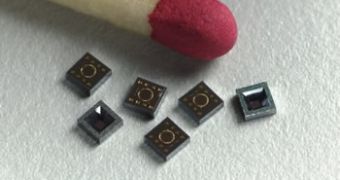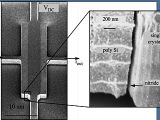Microelectromechanical systems, or MEMS, seem to have found a new possible application lately as oscillators that produce frequencies in the radio wavelengths through vibrations taking place inside them, to replace or enhance the current quartz and other oscillators, thus integrating them economically onto silicon chips as clock generators. Silicon microresonator devices can generate at this moment a top frequency of only 4.5 gigahertz, and a quality factor of 10,000.
Researchers from Cornell University believe that they can exceed this upper limit with the help of MEMS consisting of tiny silicon bars that vibrate through a process called 'dielectric transduction'. "You can trade off quality factor for frequency, so you want to maximize their products - frequency multiplied by Q," said Cornell University assistant professor of electrical and computer engineering Sunil Bhave. The quality factor, or Q of a oscillating signal reveals how sharply tunned the oscillator is, thus the energy of the resonator.
Usually the relation between the frequency of an oscillator and its factor quality is inversely proportional, however the scientists succeed in turning that relation into a directly proportional relation, so they could finally have more leeway. With the help of graduate student Dana Weinstein, Bhave was able to create a microelectromecanical system that uses an alternating voltage to separate the tiny silicon bar from the dielectric, thus inducing mechanical vibrations into the device.
The chosen dielectric material was air, since solid dielectrics obstructs the measurement of the oscillation when the resonator reaches high frequencies. Additionally, solid dielectrics also cushion the vibrations and reduce the efficiency of the energy transmission to the oscillator. Mathematical calculations showed that, by moving the dielectric layers from the ends of the bar to the middle, the efficiency of the resonator should in fact increase. With the dielectric positioned two-thirds from the middle, they were able to achieve a maximum efficiency.
The silicon MEMS are only 8.5 microns long, 40 microns wide and 2.5 thick, and are separated by two dielectric layers of silicon nitride and can produce a 4.5 gigahertz signal in the ninth harmonic. The Cornell team argue that future MEMS resonators could be able to produce frequencies far higher than 10 gigahertz.

 14 DAY TRIAL //
14 DAY TRIAL // 
